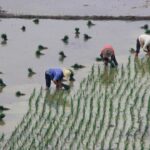In the year 1969 I turned 20 and the world’s human population reached 3 billion. Of those 3 billion, 25% or 750 million were malnourished, unable to find or grow sufficient food to meet minimum daily nutritional requirements.
In the year 2011 when I reached the age of 62 the world’s human population had grown to 6.9 billion. Of those, 13% or 897 million were not getting minimum daily nutrition. Interestingly enough 13% of our global population in 2011 was characterized as obese.
The growth in those going hungry over the 42 years was just under 20%. Some how we managed to increase food production to feed an additional 3.7 billion.
The reasons given: the rapid growth in the use of fertilizer, and mechanization.
By 2050 when I am 101, the world’s human population will have reached 9.5 billion based on United Nations projections. Will more than 1 billion of us go to bed hungry each night? Or will we see the pace of innovative agricultural science and technology continue to accelerate providing food for all? I’m betting on the latter more than the former. Why?
- In the Developed World we are modifying plants through selective breeding and genetic manipulation to increase yields. Are these yield increases as dramatic as what Brazil experienced over the last 40 years, that is food production increases of 150% even though land under cultivation only grew by 27%? Probably, and I’ll tell you why below.
- In the Developing World we are moving from a subsistence small holdings model to more mechanized cultivation with better agricultural practices and new varieties of staple crops that can tolerate poorer soils and drier conditions. Will this mean bumper crops that give Developing World nations the means to feed their own and even export surpluses? Probably, and I’ll tell you why below.
Agricultural Best Practices in the Developed World
Today, farmers are practicing scientific agriculture, making decisions based upon geography and climate. Farmers are more computer literate than most and they do lots of research online to learn what other farmers are doing to overcome challenges. They have access to geographic information systems (GIS), meteorological data, soil chemistry analysis, and many other tools to help them plant, fertilize, irrigate and harvest crops. Best practices include:
- Crop rotation – Practiced from Medieval times to today, rotating crops in fields to retain soil fertility has been an effective strategy for maintaining high yields. In North America typically farmers plant a leafy crop, followed by vegetables, followed by grains. The practice of green manure, a crop grown and plowed under to restore fertility, helps maintain healthy soils. Rotation also minimizes the need to apply chemical fertilizers and pesticides.
- Zero tillage – Today farmers seed fields without disturbing the stubble remaining from the last harvest. By not constantly turning over the soil farmers are learning to reduce the time and costs of tilling fields while minimizing soil erosion and water loss through evaporation.
- Increasing biodiversity – Farmers are learning to move away from being single crop specialists to becoming diverse growers of many food crops. Factory monoculture farms while efficient are increasingly subject to the economic highs and lows of commodity markets. Biodiversity ensures that farms have many crops and many markets in which to sell them.
- Rethinking land use – “They paved paradise and put up a parking lot,” is a phrase I often think of when I look at the loss of farmland around my city, Toronto. Where past land use practices have led to urban sprawl and depleted reserves of good agricultural land, planners today are beginning to reserve farmland in proximity to cities, and are developing urban farms within cities. In Detroit, a hollowed-out city that has experienced an urban population decline over the last few decades, abandoned housing and lots are being converted to farmland to provide local grown food to urban dwellers.
- Adapting to climate change – Farmers more than ever are learning to apply science to determine when and what to plant. In temperate and cold climate zones like much of the Canadian and American Mid-West, changes to the growing season are altering planting dates. Growing seasons are extended. Precipitation patterns are impacting soil moisture and chemistry and changing irrigation requirements.
- Genetically modified (GMO) crops – Although there are many who protest against using GMO, farmers are very much into the business of growing new varieties of crops, many genetically altered, to deal with increased heat, soil salinity, drought and agricultural pests (weeds and insects).
Changes in Farming Practices in the Developing World
If we are to achieve the goal of feeding all humanity by 2050 then agricultural yields globally need to grow, but nowhere more than in Developing World countries where we will see the greatest population increases. In its forecasts the United Nations Food and Agriculture Organization (FAO) see food requirements growing by 70% by mid-century with local farmers producing the bulk of what will be needed to meet the demand. What will it take to change agricultural practices in Sub-Saharan Africa and South Asia? Farmers need to increase capacity by putting more land under cultivation or by intensifying the use of existing farmland. This means a move away from farms capable of growing only enough to feed one family to farms that yield substantial surpluses.
What are some best practices for Developing World farms?
- Improving soils – There are expensive and inexpensive ways to accomplish this. The expensive way is importing chemical fertilizers which for Developing World farmers represents a poor solution. The inexpensive way, however, involves composting manure and crop residue and applying it properly to take into consideration what nutrients best suit what farmers are planning to grow.
- Water harvesting – Water is almost as scarce as capital in some areas of Sub-Saharan Africa. Today only 20% of agricultural land in the Developing World is irrigated and this land generates 130% greater yields than non-irrigated farms. Irrigation technology, not all of it high tech, can ensure that there is more than enough water to meet agricultural demand. A good example of low tech is clay pot irrigation (see image below), successfully used for years in Sub-Saharan Africa where precipitation is unpredictable. Another is planting pits. By excavating land and creating pits where organic matter can be applied, farmers can concentrate nutrients and water, eliminate erosion and increase yields.
- Crop selection and seed production systems – Growing the right combination of crops and developing seed production systems that yield new varieties for field testing will allow Developing World farmers to increase yields. Crop choices should be those that are native to their localities. Improvements can be made through cross-breeding different strains, or through genetic modification. A good example of this is the ICTA Ligero bean. In Guatemala a new variety introduced has proven resistant to the Golden Mosaic Virus, a major scourge. The bean provides two crops each season and is now being grown in Haiti with 34 seed producer groups involved in its distribution.
- Harvesting process improvements – Finding ways to efficiently harvest, preserve and transport field crops will dramatically increase the amount of food that farmers can deliver to consumers. This means better infrastructure on farm sites, better roads, and local refrigeration and drying systems. Today many farms in the Developing World store crops in bags made from fiber or plastic. The on site storage buildings have dirt floors with no doors and windows. As a result spoilage produces a 15-20% loss from each harvest. In countries like Afghanistan, farmers are receiving funding from Germany to develop local technical capacity to build proper farm storage buildings. This is leading to the development of artisans with technical skills as blacksmiths and tinsmiths, whose skills can be applied to other infrastructure requirements throughout the country.

Implementing the above and developing a micro-loan program within Developing World countries to provide the capital needed to realize these improvements will address the challenges of providing enough food to sustain human population growth to 2050 and beyond. We have the means to further reduce not only the percentage of people who go to bed hungry each night, but the absolute number to far less than the 897 million I reported earlier in this posting.










While I am not fond of the UN Agenda 21 plans to manage the food belts globally, I would favor having each country’s government commit to investing a percentage of their own GDP to developing their farming industry. This would stimulate their local economies and encourage growth of the entire industry, regardless of regional politics. Governments and their agendas may change, but this basic human need does not. Just a thought…
Hi Dave, Governments in both the Developed and Developing World spend billions on the farm industry. I don’t believe it is a specific percentage of GDP. But just from my “Google alert” feeds that I get each day on farming, government policy on agriculture, and agricultural technology, I cannot help but be amazed by just how many governments are actively working with farmers to help them in crop selection, marketing of yields, dealing with insect and other infestations, developing new crop strains, advising on climate change impacts, etc. But what is missing in the Developing World is a mechanism for funding technological innovation in farming. Today I belong to Kiva.org, a not-for-profit that extends micro-loans to the Developing World for projects and business pursuits. Why aren’t governments in the Developing World working with their banking institutions to provide much more in the way of available capital to improve agricultural output? This would be an effective public-private partnership. Combined with educational programs and manageable loans, farmers in the Developing World could easily produce the food needed by their countries and even develop an export industry for bumper crops. A good example of how not to do it is Nigeria. Back in the 1980s Nigeria was a net exporter of food. Then the oil industry became the means by which Nigeria earned revenue for its government. Agricultural policies were totally neglected. Today Nigeria is a net importer of food with billions of dollars spent to keep its growing population fed. This in a country with some of the most fertile land in Africa and a country with adequate water resources at least in the southern half.
Len says: “We have the means to further reduce not only the percentage of people who go to bed hungry each night, but the absolute number to far less than the 897 million I reported earlier in this posting.”
Why not say, “We have the means to reduce the number of people that are eating food produced by heroic technical means”? The Earth could easily produce enough food to feed 16-billion, but then average food costs would likely double. Hence the number of hungry poor people would likely rise. If we cut food demand by 30% (fewer eaters), food production would focus on most efficient regions (abundant rain/water and better soils), and food prices would fall. Then poor people would have more to eat.
High and rising farmland prices are the main factors driving technical trends to produce greater yields per acre, not the humanitarian desire to feed the poor. Most farmers do not own their land and machinery outright; it’s mortgaged. Maximum yield per acre is needed to service the loans on the expensive land and equipment. Too many people want to eat, and that is driving up farmland prices. The only way to feed the poor is to reduce food prices, and the only way to do that is to either reduce demand for food or reduce farmland prices.
In an ideal better world, government would assign some minimum number of fertile acres for free to every fool that wants to farm. We have a world where some poor families must hard scrabble farm ½ acre while other rich families can farm thousands of acres with millions of dollars of machinery (in the past they farmed with human slaves, but the internal combustion engine powers machinery that is more productive than slaves at lower costs). Where is the justice in that? The food problem is merely one of the major symptoms of the over-population problem.
The human population bomb is still exploding and we won’t see it plateau until mid-century. What will stop it? Urbanization! As more Developing World citizens move to urban centres fertility rates will decline. This is consistent with current trends in placing like Lagos, Nigeria, the fastest growing urban centre in the world.
Small farm holdings characterize much of the Developing World. The kinds of solutions that will work in these settings are far different from those in the Great Plain states of America. The best mechanism for agricultural intensification and technical innovation in the Developing World is a robust financial support system in the form of micro-loans. Small farm holders don’t need a lot of money to turn farms from subsistence to surplus. They need to be able to make small low tech investments. They need their governments to support scientific advancements and farm education to improve yields. They need seed banks producing higher yield, adaptive crops that can not only feed them but feed their neighbours in nearby towns and cities.
You say in an ideal world governments would assign fertile acres to any damn fool who wants to farm. That’s exactly what happened in the Canadian and American West in the 19th and early 20th century. Unfortunately today there is no land grab. We have a finite resource but also have the means to improve how we use the land we have.